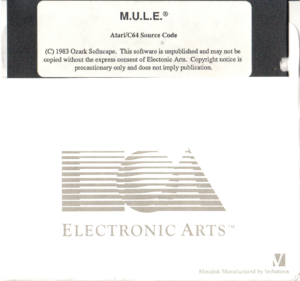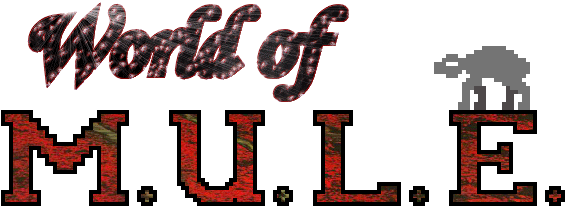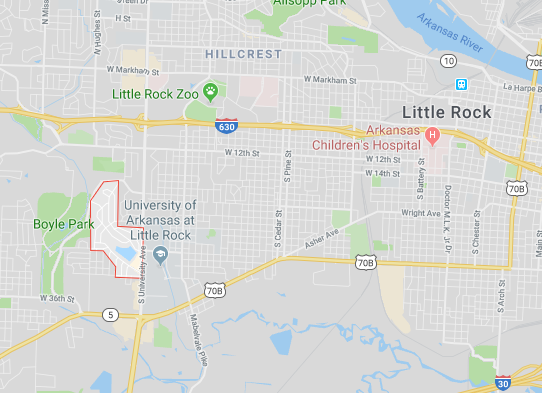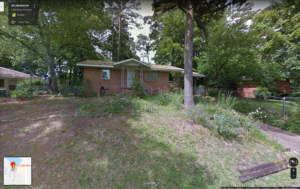Author: Goethe
This ever-growing executive summary is fed by the ever-growing Complete list of M.U.L.E. insights from the original development team.
Last updated: May 2020
- The economic simulations of “Cartels and Cutthroats”, an earlier game from Dan Bunten for publisher SSI, were some inspiration for the economics of M.U.L.E.
- The game of Monopoly was some inspiration for the social elements of M.U.L.E. manifesting themselves only when played with as many human players as possible, based on Dan Bunten’s and Alan Watson’s family board gaming experiences from childhood
- The M.U.L.E. background story of colonizing a distant planet with meager initial resources and the colony ship returning after a time, was inspired by the chapter “The Tale of the Adopted Daughter” from Robert Heinlein’s sci-fi work “Time Enough For Love”.
- The M.U.L.E. itself was also inspired by that same story – the colonists in Heinlein’s novel did bring enslaved, genetically modified mules with them. The Ozark team removed the slavery element for obvious reasons.
- According to Jim Rushing (source), inspiration is also from the concept of the old Wild West (~1800) where you could still strike your fortune “with forty acres and a mule”.
- The planet (Irata) is Atari spelt backwards, duh…
- The Wampus is a tribute to the old BASIC game “Hunt the Wumpus” the Ozark Softscape founders knew from learning BASIC programming.
- The Ozark Softscape people involved and team’s roles for M.U.L.E. development were
- Dan Bunten: Lead Design, Programming
- Jim Rushing: Design, Programming
- designed and programmed the auction sequence (Making of M.U.L.E.)
- met Dan Bunten via Bill Bunten, already worked together on “Cartels and Cutthroats” (Mechanical Donkeys)
- Alan Watson: Design, Graphics, Programming
- Quoting Alan from the 2012 Arkansas Time Article comments: “I was one of the 4 that were the original Ozark Softscape. I worked with Dan from before Ozark Sofscape (porting one of his earlier games to the Atari platform, 1980 to 1981), then all the Ozark Softscape games and ports until we finished Command HQ (Microplay 1991).”
- In terms of programming, Alan focuses on interface code (joystick/keyboard) and graphics design. See details in his 2015 ANTIC interview here: ANTIC Alan Watson Interview
- Inspiration for M.U.L.E. design came from the recent Star Wars movie (Making of M.U.L.E.)
- Bill Bunten: Design, Business Administration
- Roy Glover: Music, Sound
- Testing:
- All of the above-mentioned
- Some of the playtesting of M.U.L.E. during it’s development time was apparently “outsourced” to the local Apple computer club (“Apple Addicts” in times of yore, “Apple Rock” nowadays) in Little Rock, Arkansas where Ozark Softscape was headquartered, in evening play sessions. Dan Bunten served as first president of Apple Addicts (Mechanical Donkeys). In his above-mentioned ANTIC interview, Alan Watson mentions that these playtesting sessions were twice a week with anywhere between 8 and 20 people.
- According to the game packaging, it was tested “3.500 hours.” According to Trip Hawkins (Making of M.U.L.E.), this number is “probably tongue in cheek and a wild guess”
- At Electronic Arts, the roles were as follows:
- Joe Ybarra: Producer, Design input, playtesting
- “200-400 of hours of playtesting” (Mechanical Donkeys) over four months
- joined EA in the Producer role for Dan Bunten in fall of 1982 (Making of M.U.L.E.)
- contributed world map concept (Mechanical Donkeys)
- Trip Hawkins: Executive Sponsor, Design input, testing, writing the game manual (!)
- played a key role in designing the economics (Making of M.U.L.E.)
- initiated M.U.L.E. development because he wanted to make an improved version of “Cartels and Cutthroats”, but couldn’t secure the rights, so approached Dan Bunten (creator of “Cartels and Cutthroats”) directly (Making of M.U.L.E.).
- Joe Ybarra: Producer, Design input, playtesting
- M.U.L.E. development
- according to Joe Ybarra (Making of M.U.L.E./Mechanical Donkeys), development time was roughly six months, from October/November 1982 until May 1983 when it launched (on May 23rd).
- during development, it was called “Planet Pioneers” (Making of M.U.L.E.)
- EA insisted on the name “Moguls from Mars” for the game, but due to the cool title screen and some “shrewd procrastination” by Ozark Softscape, Ozark Softscape managed to keep the name M.U.L.E. (source)
- M.U.L.E. was developed with a custom-built toolchain on an Apple II, with the ability to cross-compile for Atari 800/400 and Commodore 64 targets
- Ozark did only write themselves the Atari and the Commodore port; all other ports (see below) were developed by different teams
- The Atari port is the original version of M.U.L.E.; Commodore 64 version came second.
- The Ozark Softscape offices where M.U.L.E. was developed were located in a rented house, in a “luxurious neighborhood” (according to Alan Watson), at 27 Lakeshore Drive near Broadmoor lake in Broadmoor, Little Rock, Arkansas 72203 (source).
- during development time, the Ozark founding team practically “lived” in this “office”
- For significant project milestones, the group went celebrating at “Slick Willy’s” sports bar in Little Rock, near the main Post Office.
- M.U.L.E. development (continued)
- A “holy grail” of M.U.L.E. history – maybe the only surviving copy of the M.U.L.E. source code – is currently in the hands of Julian Eggebrecht of Factor 5, as he disclosed in StayForever Podcast April 11th 2020, when he talked about his involvement with M.U.L.E. in the late 1980’ies / early 1990’ies for the development of “Deluxe M.U.L.E. for the Commodore Amiga“.

owned by Julian Eggebrecht
- Intellectual property rights of M.U.L.E.
- According to Alan Watson (ANTIC interview), Ozark Softscape kept ownership of the rights to the M.U.L.E. code; EA was only publisher for the game and responsible for the copy protection on the disk, and the packaging and distribution. Quoting Alan: “We [Ozark] owned up the code for M.U.L.E., they [EA] never owned that.”
- According to Jim Rushing (Mechanical Donkeys), “the rights to M.U.L.E. are owned by Dan Bunten’s estate, although I can’t say with any certainty. Dan may have assigned the rights to EA during the aborted Genesis version. When I left Ozark, Dan bought my interest in the product, and as the others left, he became the sole owner of the property.”
- According to Dani Bunten in her website and Halcyon Days interview (source), “in perfect irony even though the rights to the game and the design have reverted to me, EA owns the name [M.U.L.E.] (the name they didn’t want us to use)!“
- According to the United States Patent and Trademark Office (USPTO), the trademark “M.U.L.E.” expired in 2006 when it was not renewed by Electronic Arts. It is currently “inactive” and not claimed by any other legal entity. Link to full M.U.L.E. USPTO entry.
- “Ozark Softscape” is not a USPTO registered trademark. www.ozarksoftscape.com is still registered, but inactive these days (last checked May 2020). In the 2010’s, it was actively run by Melanie Bunten – Dan Bunten’s daughter – who sold some M.U.L.E. merchandise there (posters, t-shirts) and supported “officially Ozark Softscape endorsed” M.U.L.E. projects and products such as
- Planet M.U.L.E. for PC (as of May 2020, still active)
- M.U.L.E. Returns for iOS & Android (released 2013, discontinued in 2018)
- The M.U.L.E. board game from Lautapelit
- Commercial figures
- Launch date of M.U.L.E. was May 23rd 1983 (Mechanical Donkeys). According to Trip Hawkins, this was only Atari 800. Other versions such as Commodore 64 came later (NES much later).
- According to Trip Hawkins (Making of M.U.L.E.), M.U.L.E. sold only about 20.000 copies. Dani Bunten cites that 30.000 copies were sold, and Dani specifically mentions (source) that this number only refers to the Atari version, and C64 version sold additional numbers (which are unknown as of May 2020).
- in his ANTIC interview, Alan Watson mentioned that “early on it was estimated that only 1 in 12 copies of M.U.L.E. played were purchased”
- In 1984, when visited by an Arkansas Times reporter, Ozark Softscape had a “gold disk” on their walls indicating that “the various versions of M.U.L.E. made over 1 million US$ in sales. Most likely, this also refers to the combined sales of the two original versions, Atari+Commodore.
- Sales figures for the other 1980’ies classic ports (IBM PCjr, MSX, Sharp) are unknown as of yet.
- Sales figures of 1990 NES port is unknown as of yet.
- Sales figures of M.U.L.E. Returns (iOS/Android) are unknown as of yet.
- Ports of the original M.U.L.E. to other platforms
- succeeded:
- IBM PCjr (1985, ported by K-Byte)
- “IBM paid EA to make this version” (Trip Hawkins, Mechanical Donkeys)
- MSX (ported by Bullet Proof Software)
- Sharp X1 (ported by Bullet Proof Software)
- NES (1990, ported by Mindscape)
- IBM PCjr (1985, ported by K-Byte)
- failed:
- Atari ST (1987)
- Commodore Amiga (1988)
- Sega Genesis (from the 2012 Arkansas Times article: “In 1993, after the scrapping of Son of M.U.L.E. for the Sega Genesis over the disagreement with EA to add guns and bombs to it, there was a plan to transfer the original “M.U.L.E.” to the Sega Genesis console. This plan was also scuttled, and Ozark Softscape closed soon after.” )
- succeeded:
- Bunten’s plans to re-design M.U.L.E. for the internet age as “Planet Pioneers”
- reportedly (by Happy Puppy, Greg Costikyan), Dani Bunten already had a finished design to revive M.U.L.E. for the internet age and was just looking for a venue to bring it to life.
- This finished design is what Dani referred to in her email to WoM in 1998. She referred to this new-old game as “Planet Pioneers” – referring back to the original codename of M.U.L.E. during it’s development time.
- This finished design/concept is also what Melanie Bunten Stark may have referred to in her quote in the 2012 Arkansas Times article: “[Melanie] found what she calls “her best kept secret”: a never-before-seen sequel to “M.U.L.E.” She said she’s waiting for the right time and the right publisher to come along before letting the public get a peek at it.”
- This finished design is considered to be the “holy grail” for M.U.L.E. fans world-wide…


